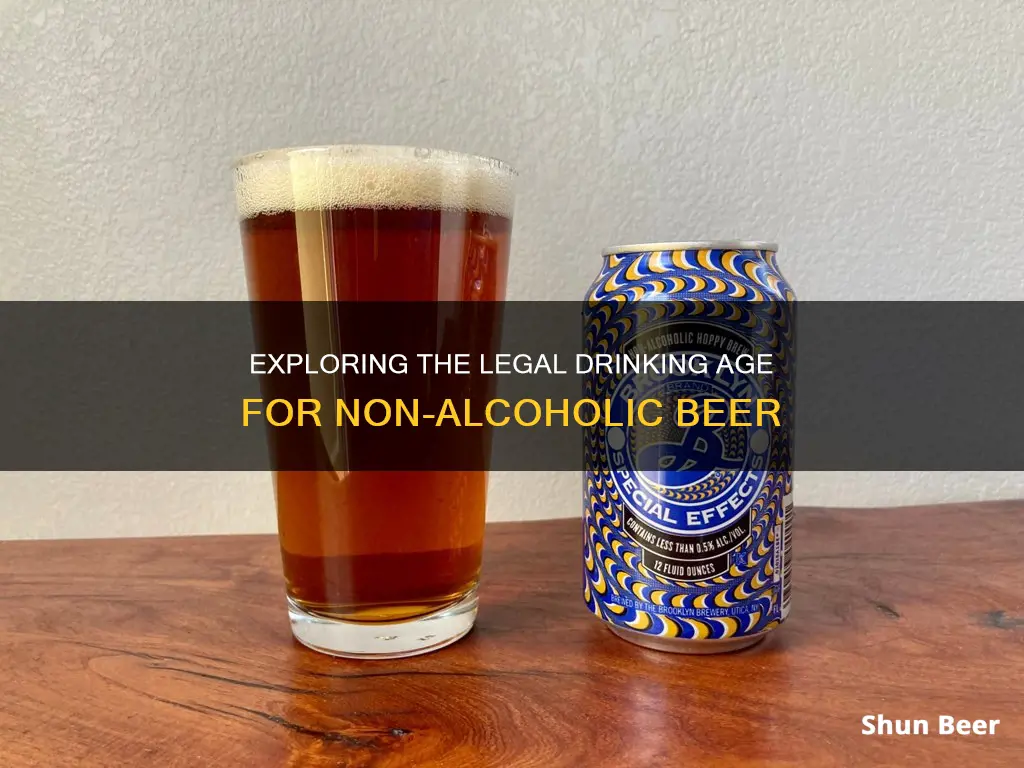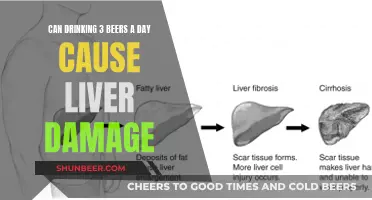
Non-alcoholic beer has become increasingly popular, with people seeking to enjoy the taste of beer without the intoxicating effects of alcohol. Despite the absence of alcohol, non-alcoholic beers typically contain up to 0.5% alcohol by volume (ABV), which is significantly lower than the 4-6% ABV found in traditional beers. Due to this minimal alcohol content, non-alcoholic beers fall into a legal grey area regarding consumption and purchase age restrictions. While the National Minimum Drinking Age Act of 1984 prohibits the sale of alcoholic beverages to individuals under 21, it does not specifically address non-alcoholic beers. As a result, the regulations surrounding non-alcoholic beer vary across different states in the US. While some states allow minors to purchase and consume these beverages, others have imposed restrictions, and a few remain undefined or ambiguous. This discrepancy has sparked debates about the potential impact of non-alcoholic drinks on underage drinking and the need for consistent age limits.
| Characteristics | Values |
|---|---|
| ABV | Non-alcoholic beer typically contains less than 0.5% ABV. |
| Legality in the US | The National Minimum Drinking Age Act of 1984 prohibits the sale of alcoholic beverages to those under 21. However, this does not apply to non-alcoholic beer, and laws vary by state. |
| Legality for minors in the US | In some states, minors can legally consume non-alcoholic beer with parental permission and/or in the presence of a parent or guardian. |
| Health concerns | Some researchers argue that non-alcoholic beer could be a gateway to drinking for children and advocate for age restrictions on purchasing. |
What You'll Learn

Non-alcoholic beer is federally consumable by anyone under 21
The laws surrounding the consumption of non-alcoholic beer for those under 21 are complex and vary depending on location. In the United States, the legal drinking age for alcoholic beverages is 21. However, non-alcoholic beer is a little different.
Non-alcoholic beer typically contains less than 0.5% alcohol by volume (ABV), which is significantly lower than the ABV of traditional beer, which is usually between 4-6% ABV. Due to its low alcohol content, non-alcoholic beer is often considered legally consumable by anyone under the age of 21 at a federal level. The National Minimum Drinking Age (NMDA) Act of 1984 defines "beer" as an "alcoholic beverage" containing "one-half of 1% or more of alcohol by volume". Therefore, non-alcoholic beer, despite its name, does not fall into the federal government's defined category of beer.
However, it is important to note that the laws regarding the purchase and consumption of non-alcoholic beer for minors differ from state to state. While some states allow minors to purchase and consume non-alcoholic beer, others do not. For example, in Mississippi, North Dakota, and Ohio, only those aged 18 and above are permitted to drink non-alcoholic beer. Additionally, 14 states prohibit minors from consuming non-alcoholic beer altogether. These varying state laws add complexity to the issue, and it is essential to check local and state regulations for specific information.
The debate surrounding the legality of non-alcoholic beer consumption for minors has sparked discussions about its potential impact on underage drinking. Some researchers argue that non-alcoholic beverages could act as a gateway to alcohol consumption for children and adolescents. They believe that the similarities in taste, smell, and cultural experience between non-alcoholic and alcoholic drinks might increase the likelihood of minors eventually trying alcoholic beverages. On the other hand, others in the industry argue that self-regulation is sufficient and that government involvement is unnecessary. They emphasize that non-alcoholic drinks are marketed towards adults and are usually placed near alcoholic beverages in retail stores, clearly indicating their intended audience.
Ultimately, while non-alcoholic beer is federally consumable by anyone under 21 due to its low alcohol content, the specific laws and regulations can vary depending on the state. It is crucial for individuals to be aware of their local laws and retailer policies before purchasing or consuming non-alcoholic beverages.
Beer After Gallbladder Removal: What You Need to Know
You may want to see also

Minors can drink non-alcoholic beer in most US states
The laws surrounding the purchase and consumption of non-alcoholic beer by minors vary from state to state. In some states, such as Oregon, West Virginia, and Wyoming, minors are prohibited from purchasing non-alcoholic beer. In other states, such as Alabama and Louisiana, minors are allowed to consume non-alcoholic beer with parental permission and/or in the presence of a parent or guardian. In Ohio, minors over the age of 18 are allowed to purchase and consume non-alcoholic beer.
While the majority of states do not have age restrictions on the purchase of non-alcoholic beverages, some retailers and online stores require customers to be at least 21 to avoid legal loopholes. Additionally, some states, such as Mississippi, North Dakota, and Ohio, only allow the drinking of non-alcoholic beer for those 18 and older. It is important to note that the laws and retailer policies vary significantly across states, so individuals should be aware of the specific regulations in their state.
Some researchers have argued for age restrictions on the purchase of non-alcoholic beverages, likening them to candy cigarettes. They believe that these drinks could be a gateway to alcohol consumption for minors and that the absence of age restrictions could lead to a potential public health issue. However, others in the non-alcoholic beverage industry believe that self-regulation is sufficient and that government involvement is unnecessary. They argue that the availability of non-alcoholic options helps adults who are trying to reduce their alcohol consumption for health reasons.
Beer and Scuba Diving: What's the Verdict?
You may want to see also

Minors can buy non-alcoholic beer in some US states
In most states, minors cannot buy non-alcoholic beer. However, there are some states that allow it, such as Ohio, where the minimum age is 18. There are also states where the laws are less clear. For example, in Alabama, the sale of non-alcoholic beer is not regulated in wet counties, but it is prohibited in dry counties.
The laws surrounding the consumption of non-alcoholic beer are also different from state to state. In some states, minors are allowed to consume non-alcoholic beer with parental permission or in the presence of a parent or guardian. For example, in Alabama, Louisiana, Mississippi, New Mexico, North Carolina, North Dakota, Ohio, Oklahoma, Oregon, West Virginia, and Wyoming, minors are allowed to consume non-alcoholic beer with parental permission. On the other hand, some states, like Alabama, Arkansas, Idaho, New Hampshire, and West Virginia, prohibit any consumption of alcohol by minors.
The varying laws regarding the purchase and consumption of non-alcoholic beer by minors in the US can be confusing and complex. As a result, many retailers choose to restrict the sale of non-alcoholic beer to those under 21 to avoid any legal issues.
Beer and Acne: Is There a Connection?
You may want to see also

Non-alcoholic beer is not completely alcohol-free
The term "non-alcoholic" can be confusing, as it may imply that the beverage contains absolutely no alcohol. However, due to the legal definition, non-alcoholic beers can contain up to 0.5% ABV and still be labelled as such. This is because the process of removing alcohol from beer can be challenging, and it is often difficult to eliminate all traces of alcohol.
It is important to note that the ABV of non-alcoholic beers can vary, and some may contain no alcohol at all. For example, Heineken 0.0 is a non-alcoholic beer that contains 0.0% ABV. On the other hand, most craft NA beers contain up to 0.5% ABV. Therefore, it is always a good idea to check the label to understand the exact alcohol content of the beverage.
The laws and regulations surrounding the sale and consumption of non-alcoholic beer can vary depending on the region. In the United States, the legal drinking age for alcoholic beverages is 21 years old. However, the laws regarding the purchase and consumption of non-alcoholic beer by minors vary from state to state. In some states, minors are allowed to consume non-alcoholic beer under certain conditions, such as parental supervision or permission. In other states, the purchase and consumption of non-alcoholic beer by minors may be prohibited altogether.
It is worth noting that even though non-alcoholic beers have a very low alcohol content, they are still regulated by the Federal Alcohol Administration Act in the United States. This is because any malt beverage, regardless of its alcoholic content, falls under the jurisdiction of the FAA. As a result, the laws and regulations surrounding non-alcoholic beer can be complex and subject to different interpretations.
Beer and Antibiotics: Is It Safe to Drink?
You may want to see also

Non-alcoholic beer is superior to alcoholic beer from a safety standpoint
The legal drinking age varies across the world. In the United States, for instance, individuals need to be at least 21 years old to purchase beverages containing alcohol. However, the laws regarding the consumption and purchase of non-alcoholic beer are less clear and vary from state to state. While non-alcoholic beverages are generally considered to be those with less than 0.5% ABV, they are still regulated by the Federal Alcohol Administration Act, and some states have their own laws prohibiting the purchase of non-alcoholic drinks by minors.
Non-alcoholic beer is often marketed as a safer alternative to alcoholic beer, and this is true in several ways. Firstly, non-alcoholic beer typically contains significantly less alcohol than regular beer, with most non-alcoholic options having less than 0.5% ABV. This means that it is very unlikely for someone to become intoxicated from drinking non-alcoholic beer, especially since the typical human liver can metabolize the equivalent of one full-strength alcoholic drink per hour.
In addition, non-alcoholic beer eliminates alcohol, a compound that is toxic and increases the risk of chronic diseases. According to the World Health Organization (WHO), alcohol contributes to 3 million deaths each year globally and is responsible for more than 5.1% of the global burden of disease. By removing alcohol, non-alcoholic beer provides a safer option for individuals who want to reduce their alcohol intake while still enjoying the taste and experience of beer.
Furthermore, non-alcoholic beer can be a good alternative for pregnant individuals or those trying to become pregnant. Alcohol consumption during pregnancy can lead to fetal alcohol spectrum disorder (FASD) and other birth defects, so it is generally recommended to avoid any alcohol during pregnancy. Non-alcoholic beer provides a way for individuals to enjoy the taste of beer without the risks associated with alcohol consumption during pregnancy.
However, it is important to note that non-alcoholic beer is not completely free of risks. Some studies have shown that non-alcoholic beers can contain more alcohol than their labels indicate, and even small amounts of alcohol can be harmful to certain populations. For example, research has found that people with liver impairments may have higher blood alcohol levels after consuming non-alcoholic beer, and pregnant individuals should avoid any alcohol consumption to eliminate the risk of FASD. Additionally, the smell and taste of non-alcoholic beer may trigger cravings and a subsequent relapse among individuals with alcohol use disorder.
In conclusion, while non-alcoholic beer is generally considered safer than alcoholic beer, it is important to be aware of the potential risks associated with its consumption, especially for certain vulnerable populations.
Understanding the Beer Guarantee: What's the Deal?
You may want to see also
Frequently asked questions
The answer depends on where you live. In the US, the National Minimum Drinking Age Act of 1984 prohibits the sale of beverages containing alcohol to buyers under 21 years of age. However, this federal law does not apply to non-alcoholic drinks, and each state has its own regulations. In some states, such as Mississippi, North Dakota, and Ohio, only those 18 and older are permitted to drink non-alcoholic beer. In other states, minors are allowed to drink non-alcoholic beverages with parental permission and/or supervision.
This depends on the state and local laws. In general, if a state allows minors to consume non-alcoholic beer, it also permits them to purchase it. However, some states, like Oregon and Wyoming, prohibit the purchase of non-alcoholic beer by those under 21.
The legal drinking age is set to protect children and consumers from the harmful effects of alcohol. According to the CDC, raising the minimum drinking age to 21 has led to a significant reduction in motor vehicle deaths. Additionally, the overconsumption of alcohol by minors can lead to fatal consequences, with an average of 3,900 deaths per year attributed to this issue.







